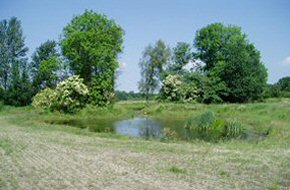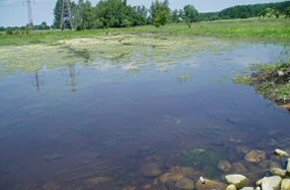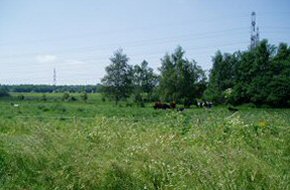Egelundsparken. Management of diverted rainwater
Delay and treatment of rainwater from a housing development in a green wetland area before discharge to watercourse – St. Vejle River and Egelundsparken.
Rainwater from a housing development in Albertslund Municipality is disconnected from the existing sewer system in order to equalise the hydraulic load and reduce the matter load of St. Vejle River.
The rainwater is fed via 2 lamellar separators to Egelundsparken, which is owned by the municipality, and from there to St. Vejle River. Groundwork has been carried out in the park, so the water is fed initially through 3 hollows along the lines of lakes, each approx. 0.1 ha. in size, from which the water flows (at a water level of approx. 50 cm) via a spillway to a large, green area which is of the nature of a wetland on account of the extra water.
From this wetland, the water seeps through the soil and a bank out into the river. The lakes and bank delay the water so that the outflow to St. Vejle River extends over a longer period. In heavy rain (Plan B), the lakes can extend over an area of 8 ha. in the park. In the event of a further load, the water runs via a spillway directly to the river. As the rainwater comes from a residential area, the rainwater is expected not to be particularly contaminated. At the same time, the solution is expected to ensure good treatment of the water before it reaches the river. Development in animal and plant life in the area is being monitored by Albertslund Naturgruppe in cooperation with the Danish Society for Nature Conservation.
Finance
Establishment cost: DKK 1.5 million in 2006
Operating costs: No operation other than the emptying of oilseparators has taken place as yet, but costs will be incurred in future for treatment of contaminated sediment.
Operation and maintenance
Oilseparators must be maintained, and the lakes must be cleaned out at regular intervals (approx. every 10 years).
Service life
Over 100 years.
Catchment
Roof water and road runoff from a residential area of 140 red. ha.
Hydraulic capacity
The area (park) is 8 ha. in size. The solution includes a plan B so that extremely heavy rain can be managed in the same area.
Max. infeed to the area is 115 l/s. The annual infeed volume is 90,000 m3/year.
Treatment
Not documented, but the following processes are expected to take place: Sedimentation of particles in the lakes, retention of heavy metals by sorption to soil material and uptake in plants, retention and breakdown of environmentally alien organic compounds by sorption, microbial degradation, uptake in plants and photolysis, or removal from the aquatic environment through evaporation. The area is grazed by cattle. Sludge from the oilseparators is transported to landfill. Sediment from the lakes will be disposed of according to the level of contamination.
Søren Gabriel and Anette Henze, advisors, Orbicon: "This solution shows how interdisciplinary cooperation can create a holistic approach and hence deal with several problems at once. Citizens feel that the three new lakes and wetlands in Egelundsparken improve the green area. At the same time, the water is treated effectively before it seeps out into the river, and the problem of insufficient flows during dry periods is reduced. Finally, it should be noted that internal cooperation within the municipality has been reinforced."
Location
Egelundparken, entry to Toftekærstien, Albertslund
Contacts
Name: Søren Gabriel
Organisation: Orbicon
E-mail: sga@orbicon.dk
Telephone: +45 46 30 03 73
Name: Hans-Henrik Høg
Organisation: Albertslund Municipality
E-mail: hans-henrik.hog@albertslund.dk
Telephone: +45 43 68 68 50
Photos



